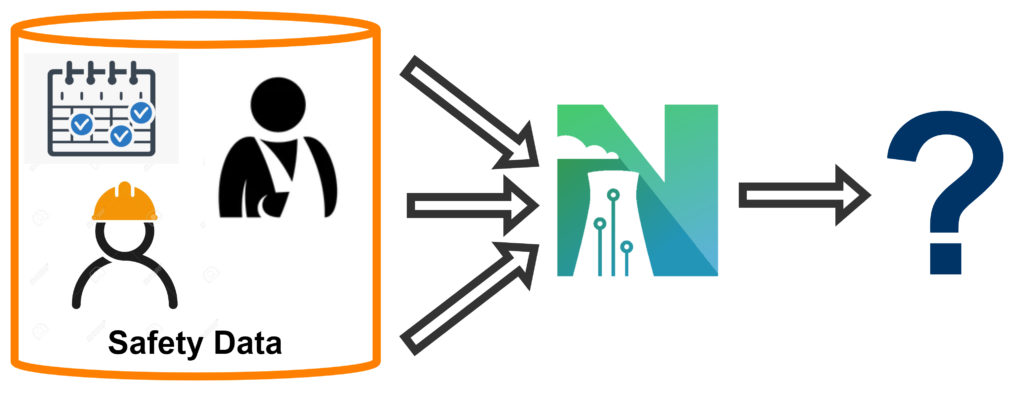Over the the last few months, we have been working on developing useful safety analytics for utilities. We’ve seen safety analytics challenges that both Nuclear Utilities and Non-Nuclear Utilities seem to have in common, specifically whether: (1) is there a way to analyze future work for potential injury risk and the types of injuries that may occur, and (2) can historically performed work be analyzed, binned, and coded to determine what kinds of safety issues seem to occur on a regular or seasonal basis? After several experiments, trials and a few new insights, we are excited to share these new Safety Analytics techniques!

Challenges with Safety Programs
Our solutions aim to solve several business problems that are surprisingly common to most utility organizations trying to analyze and improve safety performance. Some of those problems include:
(1) Scheduled safety communications can be too broad and non-specific to the work being performed which dilutes the safety message and results in a lower safety ‘signal to noise’ ratio. Employees end up disregarding communications that they learn are irrelevant, and/or spending time on information that is not directly applicable or actionable.

(2) Safety observations may not target the highest value (e.g. most risky or injury prone) activities being performed as that value is unknown or incalculable. Activities being observed may be low-risk, resulting in a confusing message to the frontline.
(3) The causes of upticks in injuries within certain workgroups are often unknown. Managers may see an uptrend in injuries within a certain group and do not have the tools, trend-codes, or identified commonalities needed to address the situation.
Our Approach
We’ve found a set of techniques that work to solve these business challenges and are pleased to offer to customers a value added safety analysis product. The solution is two part.
First, we use machine learning models to review and apply a Significant Injury or Fatality (SIF) type based on information published by the Occupational Safety and Health Administration. This allows us to draw from previous injury data to determine the most likely injuries (injury type, location on body) for any work activity. We can apply this model to future work schedules, then bucket by elements like ‘Workgroup’ or ‘Week’. The resulting analytics provide data-driven forecasts for injury risk for which tailored communications can be crafted or observation tasks assigned.
Second, we’ve developed a novel trend code application mechanism that allows us to apply brand new codes without any historically coded data! This method uses recent advancements in Natural Language Processing (NLP) techniques to break a fundamental machine learning paradigm that would otherwise require mountains of historically labeled data to provide accurate results. Using this technique we have been able to create a suite of trend codes based directly on the OSHA Safety and Health Program Management Guidelines. This allows us to analyze safety data in a way that has never been done before, generating new, actionable insights for improving industrial safety.
Nuclearn Safety Analysis
These two new approaches come together to deliver our Nuclearn Safety Analysis product.

This PowerBI dashboard shows a forecasted increased level of exposure to potential burn injuries, particularly the ‘maint’ organization to increased burns due to sulfuric acid sump inspections. The ‘ismc’ org is at particular risk for cuts and lacerations first, with electric shock second. Using these insights, tailored communications would be sent to these groups in a ‘just-in-time’ format to address potential challenges and reduce the risk of a significant injury.

Again, this PowerBI dashboard shows a high proportion of OSHA.MW.4 (hazard prevention and control at multiemployer worksites), followed by OSHA.PE.2 (correct program deficiencies and identify opportunities to improve). Analyzing over time, we see oscillation of some safety codes as well as seasonal volatility of certain codes.
By leveraging Nuclearn Safety Analysis, utilities can begin taking informed actions to improve industrial safety in ways never before possible:
- A safety analyst or communications professional can automatically review and analyze weeks or months of both forward looking and historical work activities for safety impact. They can use this information to tailor impactful and actionable safety messages that cut through the safety noise and drive results at the organizational level.
- Observation program managers can use the forward looking results to assign observation resources to the riskiest work with the highest likelihood of severe injury.
- Front line managers can review tasks for their given work groups and adjust pre-job briefs or weekly meetings to put preventative measures in place for the weeks activities.
To learn more about Nuclearn’s Safety Analysis offering and the Nuclearn Platform, send us an email at contact@nuclearn.ai.
